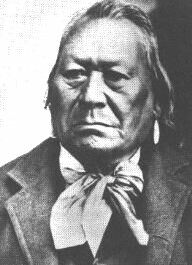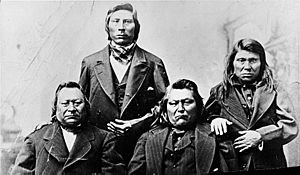Chief Moses facts for kids
Chief Moses (born Kwiltalahun, later called Sulk-stalk-scosum - "The Sun Chief") (c. 1829 – March 25, 1899) was an important Native American chief. He led the Sinkiuse-Columbia tribe in what is now Washington state. His tribe lived in the Columbia Basin, often near Moses Lake.
Contents
Early Life and Education
Kwiltalahun was the third son of a chief named Sulk-stalk-scosum. As a child, he was called Loo-low-kin. Later in life, he took his father's name, Sulk-stalk-scosum.
When he was about nine years old, a missionary named Henry H. Spalding was very impressed by him. Moses was invited to study at a mission school in Lapwai, Idaho. For three years, he learned about the ways of white settlers. He also met many Nez Perce people there.
Moses became very good at speaking several languages. These included English, Nez Perce, Spokane, Colville, and Yakima. This skill helped him a lot later in his life. It was at the mission that Spalding gave him the Christian name "Moses." He used this name for the rest of his life, even though he did not officially become a Christian.
Becoming a Chief
During the Yakima War, Moses's brother, Kwilninuk, was the chief of the Sinkiuse-Columbia. Moses played a smaller role in the war. After their defeat in 1858, he surrendered. While Moses was away, his tribe chose him to be their new chief. When he returned, he took on the duties and the name of his father, who had passed away.
Chief Moses led the Sinkiuse-Columbia for forty years. During this time, more and more white settlers moved into their lands. This led to many conflicts. Chief Moses worked hard to protect his people. He tried to find ways for them to live peacefully with the changing world around them.
A Difficult Trial
In 1878, a white couple was killed near Rattlesnake Springs. The military, however, blamed Chief Moses for the incident. He was captured and put on trial in Yakima. Luckily, he was found not guilty.
According to tribal records, Chief Moses was asked to travel to Washington D.C. in February 1879. He went with other tribal leaders and met with President Rutherford B. Hayes. Moses understood that the outcome of his trial might depend on whether he agreed to give up his land. He told the president, "You want this land, fine." The charges against him were dropped a few months later.
The Columbia Reservation
On April 18, 1879, the United States government set aside land for Chief Moses and his tribe. This land was called the Columbia Reservation. In return, the tribe agreed to give up their original territory in the Columbia Basin. This land was then opened for white settlers to claim.
The new reservation was located north of the tribe's original lands. It had different types of land. White settlers, including miners and ranchers, were already living in parts of this new reservation area. They did not want the reservation to be created. They asked the government to pay them for their properties if the reservation went ahead.
The government put the army in charge of the reservation. Chief Moses complained that white settlers were still on the land, even though he had been promised they would be kept out. The army tried to get the settlers to leave and assessed the value of their properties.
However, fewer than 100 members of Moses's tribe moved to the new reservation. Chief Moses himself moved to the Colville Indian Reservation, which was just east of the Columbia Reservation. The settlers began to ask the government to get rid of the Columbia Reservation. They wanted the Sinkiuse-Columbia tribe to move to the Colville Reservation instead.
Some violence broke out in 1882, with settlers damaging Native American property. Order was quickly restored. In 1883, President Chester A. Arthur signed an order that gave a strip of land along the Canada-US border back to the public. Chief Moses and other leaders went to Washington, D.C. again to discuss these issues.
Later Developments and Legacy
An agreement was reached in July 1883. The government agreed to buy the entire Columbia Reservation from the Native Americans. Tribe members could choose to move to the Colville Reservation or receive their own plots of land. In 1884, the entire reservation was opened up for white settlement. Many settlers moved in, and the area became Okanogan County a few years later.
Chief Moses passed away in 1899 on the Colville Reservation. He was buried near Nespelem, Washington.
Chief Moses once asked a follower to count the grains of sand in a pile. The man said, "There are too many." Moses replied, "It is the same with whites. There are too many." This story shows his wisdom and how he saw the changes happening around his people.
Many places are named after Chief Moses. These include Moses Lake, Moses Coulee, and the city of Moses Lake, Washington.
His relatives include Lucy Friedlander Covington (1910-1982) and Paulette Jordan (born 1979).



